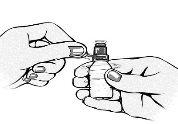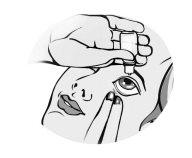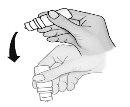

ТАПТИКОМ 15 мкг/мл + 5 мг/мл глазные капли, раствор

Спросите врача о рецепте на ТАПТИКОМ 15 мкг/мл + 5 мг/мл глазные капли, раствор

Инструкция по применению ТАПТИКОМ 15 мкг/мл + 5 мг/мл глазные капли, раствор
Введение
Проспект: Информация для пациента
Таптиком 15 микрограммов/мл + 5 мг/мл глазные капли в растворе
тафлупрост/тимолол
Прочитайте весь проспект внимательно перед началом использования этого лекарства, поскольку он содержит важную информацию для вас.
- Сохраните этот проспект, поскольку вам может потребоваться прочитать его снова.
- Если у вас есть какие-либо вопросы, проконсультируйтесь с вашим врачом, фармацевтом или медсестрой.
- Это лекарство было назначено только вам, и не передавайте его другим людям, даже если у них такие же симптомы, как у вас, поскольку оно может нанести им вред.
- Если вы испытываете побочные эффекты, проконсультируйтесь с вашим врачом, фармацевтом или медсестрой, даже если это побочные эффекты, которые не указаны в этом проспекте. См. раздел 4.
Содержание проспекта
- Что такое Таптиком и для чего он используется
- Что нужно знать перед началом использования Таптиком
- Как использовать Таптиком
- Возможные побочные эффекты
- Хранение Таптиком
- Содержание упаковки и дополнительная информация
1. Что такое Таптиком и для чего он используется
Какой тип лекарства это и как оно действует?
Таптиком глазные капли в растворе содержат тафлупрост и тимолол. Тафлупрост является лекарством из группы, называемой аналогами простагландина, и тимолол принадлежит к группе лекарств, называемых бета-блокаторами. Тафлупрост и тимолол действуют вместе и снижают давление в глазу. Таптиком используется, когда давление в глазу слишком высоко.
Для чего используется ваше лекарство?
Таптиком используется для лечения типа глаукомы, называемого глаукомой с открытым углом, состояния, также называемого окулярной гипертензией у взрослых. Оба состояния связаны с увеличением давления в глазу и иногда могут повлиять на ваше зрение.
2. Что нужно знать перед началом использования Таптиком
Не используйте Таптиком:
- если вы аллергичны к тафлупросту, тимололу, бета-блокаторам или любому другому компоненту этого лекарства (указанному в разделе 6).
- если у вас были или есть проблемы с дыханием, такие как астма, хроническая обструктивная болезнь легких (тяжелое заболевание легких, которое может вызвать свистящее дыхание, трудности с дыханием или длительный кашель).
- если у вас замедленный сердечный ритм, сердечная недостаточность или нарушения сердечного ритма (неправильный сердечный ритм).
Предостережения и меры предосторожности
Проконсультируйтесь с вашим врачом, фармацевтом или медсестрой перед началом использования Таптиком.
Прежде чем использовать это лекарство, сообщите вашему врачу, если у вас есть или были:
- сердечные заболевания (симптомы могут включать боль или сжатие в груди, трудности с дыханием или удушье), сердечная недостаточность или артериальная гипотония
- нарушения сердечного ритма, такие как медленный сердечный ритм
- дыхательные проблемы, астма или хроническая обструктивная болезнь легких
- плохая кровообращение (например, болезнь Рейно или синдром Рейно)
- диабет, поскольку тимолол может скрыть признаки и симптомы гипогликемии
- гиперактивность щитовидной железы, поскольку тимолол может скрыть признаки и симптомы заболеваний щитовидной железы
- любая аллергия или анафилактическая реакция
- тяжелая миастения (тяжелое заболевание, которое вызывает мышечную слабость)
- другие глазные заболевания, такие как заболевание роговицы (прозрачной ткани, покрывающей переднюю часть глаза) или состояние, требующее глазной хирургии.
Сообщите вашему врачу, если у вас есть
- проблемы с почками
- проблемы с печенью.
Имейте в виду, что Таптиком может иметь следующие эффекты и что некоторые из них могут быть постоянными:
Таптиком может
- увеличить длину, толщину, цвет или плотность ваших ресниц и вызвать необычный рост волос на ваших веках.
- вызвать потемнение кожи вокруг глаз. Промокните излишки раствора с кожи. Таким образом, вы уменьшите риск потемнения кожи.
- изменить цвет вашего радужной оболочки (цветной части глаза). Если вы используете Таптиком только в одном глазу, цвет обработанного глаза может стать постоянным отличным от цвета другого глаза.
- вызвать рост волос в областях, где раствор вступает в контакт с кожей повторно.
Если вы собираетесь пройти операцию, сообщите вашему врачу, что вы используете Таптиком, поскольку тимолол может изменить эффекты некоторых лекарств, используемых во время анестезии.
Дети и подростки
Таптиком не рекомендуется для детей и подростков младше 18 лет из-за отсутствия данных о безопасности и эффективности в этой возрастной группе.
Употребление Таптиком с другими лекарствами
Сообщите вашему врачу или фармацевту, если вы принимаете, недавно принимали или думаете, что можете принять любое другое лекарство.
Таптиком может повлиять на или быть под влиянием других лекарств, которые вы принимаете.
В частности, сообщите вашему врачу, если вы используете/принимаете или планируете использовать/принимать:
- другие глазные капли для лечения глаукомы
- лекарства для снижения артериального давления
- сердечные лекарства
- лекарства для лечения диабета
- хинидин (используемая для лечения сердечных проблем и некоторых типов малярии)
- антидепрессанты, известные как флуоксетин или пароксетин.
Если вы используете другие лекарства в глаз, подождите как минимум 5 минут между закапыванием Таптиком и другим лекарством.
Контактные линзы
Удалите контактные линзы перед тем, как закапать капли, и подождите как минимум 15 минут перед тем, как снова их надеть.
Беременность, лактация и фертильность
Если вы беременны или кормите грудью, думаете, что можете быть беременной или планируете стать беременной, проконсультируйтесь с вашим врачом перед использованием этого лекарства. Если вы женщина, способная к беременности, вы должны использовать эффективный метод контрацепции во время лечения Таптикомом. Не используйте Таптиком, если вы беременны, кроме случаев, когда это указано вашим врачом. Не используйте Таптиком, если вы кормите грудью. Проконсультируйтесь с вашим врачом.
Вождение и использование машин
Некоторые побочные эффекты, связанные с Таптикомом, такие как размытое зрение, могут повлиять на вашу способность управлять транспортными средствами или работать с машинами. Не управляйте транспортными средствами и не работайте с машинами, пока не почувствуете себя хорошо и ваше зрение не станет ясным.
Таптиком содержит фосфаты
Это лекарство содержит 1,3 мг фосфатов в каждом мл.
Если у вас есть серьезное повреждение роговицы (прозрачной ткани на передней части глаза), лечение фосфатами, в очень редких случаях, может вызвать размытое зрение из-за накопления кальция.
3. Как использовать Таптиком
Следуйте точно инструкциям по применению этого лекарства, указанным вашим врачом или фармацевтом. В случае сомнений проконсультируйтесь с вашим врачом или фармацевтом снова.
Рекомендуемая доза составляет одну каплю Таптикома в день в пораженный глаз или глаза. Не закапывайте больше капель или не делайте это чаще, чем указано вашим врачом. Если вы это сделаете, Таптиком может потерять свою эффективность. Используйте Таптиком в обоих глазах только если ваш врач указал это.
Для использования только как глазные капли. Не принимать внутрь.
Не допускайте, чтобы флакон с каплями касался глаза или окружающей области. Это может повредить глаз. Также может произойти загрязнение бактериями, которые могут вызвать глазные инфекции, приводящие к повреждению глаза, включая потерю зрения. Чтобы избежать возможного загрязнения флакона с каплями, избегайте касания кончика флакона любой поверхности.
Инструкции по применению:
Когда вы используете его впервые, перед тем, как закапать каплю в глаз, сначала необходимо потренироваться в использовании флакона, медленно сжимая его, чтобы капля упала вне глаза.
Когда вы будете уверены, что можете закапать одну каплю за раз, выберите наиболее удобное положение для закапывания капель (вы можете сидеть, лежать на спине или стоять перед зеркалом).
При начале нового флакона:
Не используйте флакон, если пластиковое кольцо вокруг горлышка флакона отсутствует или повреждено. Запишите дату, когда вы открыли флакон, в отведенном месте на внешней упаковке.
Каждый раз, когда вы используете Таптиком:
|
|
|
|
Будьте особенно осторожны, чтобы не допустить, чтобы кончик флакона с каплями касался вашего глаза, кожи вокруг глаза или ваших пальцев, чтобы предотвратить возможное загрязнение раствора.
Пожалуйста, обратите внимание, что может быть небольшая задержка между сжатием флакона и падением капли. Не сжимайте слишком сильно. |
|
|
|
|
|
Остается остаточный объем примерно 1 мл, который нельзя вводить. Не пытайтесь опустошить флакон.
Если капля упадет вне глаза,попробуйте снова.
Если ваш врач сказал вам, что необходимо закапать капли в оба глаза, повторите шаги с 7 по 9 в другом глазу.
Если вы используете другие лекарства в глаз, подождите как минимум 5 минут между применением Таптикома и другим лекарством.
Если вы использовали больше Таптикома, чем должно быть, вы можете чувствовать головокружение или иметь головную боль, сердечные проблемы или дыхательные трудности. Если необходимо, проконсультируйтесь с врачом.
Если вы случайно проглотили лекарство,проконсультируйтесь с врачом или фармацевтом или позвоните в Службу токсикологической информации, телефон 91 562 04 20, указав лекарство и количество, принятое.
Если вы забыли использовать Таптиком,закапайте одну каплю, как только вспомните, и вернитесь к обычному графику. Однако, если время следующей дозы уже близко, пропустите пропущенную дозу. Не принимайте двойную дозу, чтобы компенсировать пропущенные дозы.
Не прекращайте использование Таптикома без консультации с вашим врачом. Если вы прервете лечение Таптикомом, давление в глазу снова увеличится. Это может привести к постоянному повреждению глаза.
Если у вас есть какие-либо другие вопросы об использовании этого лекарства, спросите вашего врача, фармацевта или медсестру.
4. Возможные побочные эффекты
Как и все лекарства, это лекарство может вызывать побочные эффекты, хотя не все люди испытывают их. Большинство побочных эффектов не являются серьезными.
Обычно вы сможете продолжать использовать капли, кроме случаев, когда эффекты являются серьезными. В случае сомнений проконсультируйтесь с врачом или фармацевтом.
Известные побочные эффекты использования Таптикома являются:
Частые побочные эффекты(могут повлиять до 1 из 10 человек):
Глазные расстройства
Зуд в глазах. Irrитация глаз. Боль в глазах. Покраснение глаз. Изменения в длине, толщине и плотности ресниц. Чувство инородного тела в глазу. Потемнение ресниц. Чувствительность к свету. Размытое зрение.
Редкие побочные эффекты(могут повлиять до 1 из 100 человек):
Расстройства нервной системы
Головная боль.
Глазные расстройства
Сухость глаз. Покраснение век. Маленькие зоны воспаления на поверхности глаза. Слезящиеся глаза. Отек век. Усталые глаза. Воспаление век. Воспаление внутри глаза. Неудобства в глазах. Аллергия глаз. Воспаление глаза. Необычное ощущение в глазах.
Дополнительные побочные эффекты, наблюдаемые при использовании составляющих Таптикома (тафлупроста и тимолола) и, следовательно, возможные при использовании Таптикома:
Побочные эффекты, наблюдаемые при использовании тафлупроста:
Глазные расстройства
Снижение способности глаза видеть детали. Изменение цвета радужной оболочки (может быть постоянным). Изменение цвета кожи вокруг глаз. Воспаление поверхностных мембран глаза. Слезотечение. Пигментация поверхностных мембран глаза. Фолликулы на поверхностных мембранах глаза. Впалый глаз. Ирит/увеит (воспаление цветной части глаза). Отек макулы/цистоидный отек макулы (воспаление сетчатки внутри глаза, приводящее к ухудшению зрения).
Кожные расстройства
Необычный рост волос на веках.
Респираторные эффекты
Ухудшение астмы, дыхательная недостаточность.
Побочные эффекты, наблюдаемые при использовании тимолола:
Расстройства иммунной системы
Аллергические реакции, включая воспаление под кожей, крапивницу и сыпь. Внезапная и потенциально смертельная аллергическая реакция. Зуд.
Расстройства метаболизма и питания
Гипогликемия.
Психиатрические расстройства
Депрессия. Расстройства сна. Кошмары. Потеря памяти. Нервозность. Галлюцинации
Расстройства нервной системы
Головокружение. Слабость. Необычные ощущения (такие как онемение и покалывание). Увеличение симптомов и признаков тяжелой миастении (мышечного расстройства). Инсульт. Снижение кровотока к мозгу.
Глазные расстройства
Воспаление роговицы. Снижение чувствительности роговицы. Зрительные расстройства, включая изменения рефракции (иногда из-за отказа от миотической терапии). Птоз (опущение верхнего века). Двойное зрение. Размытое зрение и отслоение пигментного эпителия, содержащего кровеносные сосуды, после фильтрационной операции, что может привести к зрительным расстройствам. Эрозия роговицы.
Слуховые расстройства
Тиннитус (звон в ушах).
Сердечные расстройства
Медленный сердечный ритм. Боль в груди. Сердцебиение. Отек (накопление жидкости). Изменения сердечного ритма или частоты сердечных сокращений. Сердечная недостаточность (сердечное заболевание с трудностями дыхания и отеком ног и рук из-за накопления жидкости). Тип сердечного расстройства. Инфаркт миокарда. Сердечная недостаточность.
Сосудистые расстройства
Низкое артериальное давление. Хромота. Феномен Рейно, холодные руки и ноги.
Респираторные расстройства
Сужение дыхательных путей в легких (особенно у пациентов с предшествующим заболеванием). Трудности с дыханием. Кашель.
Желудочно-кишечные расстройства
Тошнота. Изжога. Диарея. Сухость во рту. Расстройства вкуса. Боль в животе. Рвота.
Кожные расстройства
Выпадение волос. Кожная сыпь с белым оттенком (псориазоподобная сыпь) или ухудшение псориаза. Кожная сыпь.
Мышечные и скелетные расстройства
Мышечная боль, не вызванная упражнениями. Суставная боль.
Расстройства репродуктивной системы и молочной железы
Болезнь Пейрони (которая может вызвать искривление полового члена). Сексуальная дисфункция. Снижение либидо.
Общие расстройства
Мышечная слабость/усталость. Жажда.
Сообщение о побочных эффектах
Если вы испытываете любой побочный эффект, проконсультируйтесь с вашим врачом, фармацевтом или медсестрой, даже если это возможные побочные эффекты, которые не указаны в этом проспекте. Вы также можете сообщить об этом напрямую через Испанскую систему фармаковигиланса для лекарств для человека: https;//www.notificaram.es. Сообщая о побочных эффектах, вы можете внести свой вклад в предоставление более подробной информации о безопасности этого лекарства.
5. Хранение Таптикома
Храните это лекарство в недоступном для детей месте.
Не используйте это лекарство после даты истечения срока годности, указанной на этикетке флакона и упаковке после "СГ". Дата истечения срока годности - последний день месяца, указанного.
Храните нераспечатанные флаконы в холодильнике (между 2 и 8 °C). Не замораживайте.
Храните флакон в оригинальной упаковке, чтобы защитить его от света.
После открытия флакона:
- Не храните при температуре выше 25°C. Не замораживайте.
- Храните флакон в оригинальной упаковке, чтобы защитить его от света.
- После первого открытия, чтобы избежать инфекций, необходимо выбросить флакон через 3 месяца. Флакон с объемом 3 мл предназначен для использования в течение 1 месяца, флакон 5 мл - для 2 месяцев, а флакон 7 мл - для 3 месяцев.
Лекарства не должны выбрасываться в канализацию или мусор. Поместите упаковку и лекарства, которые вам больше не нужны, в пункт SIGRE в аптеке. Если у вас есть сомнения, спросите вашего фармацевта, как избавиться от упаковки и лекарств, которые вам больше не нужны. Таким образом, вы поможете защитить окружающую среду.
6. Содержимое упаковки и дополнительная информация
Состав Таптикома
- Активные вещества - тафлупрост и тимолол. 1 мл раствора содержит 15 микрограммов тафлупроста и 5 мг тимолола (в форме малеата).
- Остальные компоненты - глицерол, дodecahydrат фосфата натрия, эдетат натрия, полисорбат 80, соляная кислота и/или гидроксид натрия и вода для инъекционных препаратов.
Внешний вид продукта и содержимое упаковки
Таптиком - прозрачная и бесцветная жидкость (раствор), практически свободная от видимых частиц. Он выпускается в упаковке, содержащей 1 прозрачный пластиковый флакон, содержащий 3 мл, 5 мл или 7 мл, или 3 прозрачных пластиковых флакона по 3 мл раствора каждый. Пластиковые флаконы закрыты пробками.
Возможно, что будут продаваться только некоторые размеры упаковок.
Владелец разрешения на маркетинг и производитель
Владелец разрешения на маркетинг
Santen Oy
Ниittyhaankату 20
33720 Тампere
Финляндия
Производитель
Santen Oy
Кelloпортinkату 1
33100 Тампere
Финляндия
Более подробную информацию о этом лекарственном средстве можно получить, обратившись к местному представителю владельца разрешения на маркетинг:
Santen Pharmaceutical Spain S.L.
Акантo, 22, 7-й
28045 – Мадрид
Дата последнего обновления этой инструкции: ноябрь 2021 г.
Подробная и актуальная информация о этом лекарственном средстве доступна на сайте Агентства по лекарственным средствам и медицинским изделиям Испании (AEMPS) http://www.aemps.gob.es/
- Страна регистрации
- Активное вещество
- Требуется рецептДа
- Производитель
- Информация носит справочный характер и не является медицинской рекомендацией. Перед приемом любых препаратов проконсультируйтесь с врачом. Oladoctor не несет ответственности за медицинские решения, принятые на основе этого контента.
- Аналоги ТАПТИКОМ 15 мкг/мл + 5 мг/мл глазные капли, растворФорма выпуска: ГЛАЗНЫЕ КАПЛИ, 10 мг/мл + 5 мг/млАктивное вещество: timolol, combinationsПроизводитель: Novartis Europharm LimitedТребуется рецептФорма выпуска: ГЛАЗНЫЕ КАПЛИ, 0,3 мг/мл + 5 мг/млАктивное вещество: timolol, combinationsПроизводитель: Brill Pharma S.L.Требуется рецептФорма выпуска: ГЛАЗНЫЕ КАПЛИ, 0,3 мг/мл + 5 мг/млАктивное вещество: timolol, combinationsПроизводитель: Laboratorio Stada S.L.Требуется рецепт
Аналоги ТАПТИКОМ 15 мкг/мл + 5 мг/мл глазные капли, раствор в других странах
Лучшие аналоги с тем же действующим веществом и терапевтическим эффектом.
Аналог ТАПТИКОМ 15 мкг/мл + 5 мг/мл глазные капли, раствор в Польша
Аналог ТАПТИКОМ 15 мкг/мл + 5 мг/мл глазные капли, раствор в Украина
Врачи онлайн по ТАПТИКОМ 15 мкг/мл + 5 мг/мл глазные капли, раствор
Консультация по дозировке, побочным эффектам, взаимодействиям, противопоказаниям и продлению рецепта на ТАПТИКОМ 15 мкг/мл + 5 мг/мл глазные капли, раствор – по решению врача и с учетом местных правил.



















